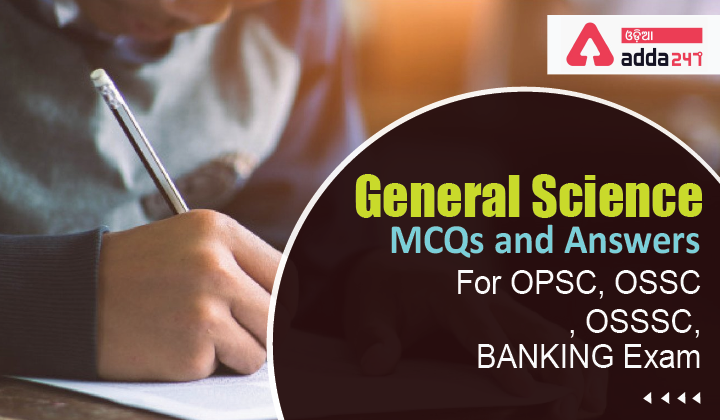General Science MCQs and Answers: General Science are very important for OPSC, OSSC, OSSSC & Other State Exams. Aspirants who are willing to apply for the various Government exams in 2022 must go through the topics of General Science for competitive exams, as General Science is a key part of the syllabus.
Download ADDA247 Odia APP – Appear Latest Exam Test Series & Live Classes
Q1. Using which of the following processes can one separate a solute from its solution?
(a) Sedimentation
(b) Evaporation
(c) Filtration
(d) Condensation
S1. Ans.(b)
Sol. Evaporation is a type of vaporization, that occurs on the surface of a liquid as it changes into the gaseous phase.
Q2. Which acid is found in ants?
(a) Formic acid.
(b) Oxalic acid.
(c) sulphuric acid.
(d) acetic acid.
S2.Ans(a)
Sol. Acid found in ant is Formic acid. Othe name of Formic acid is :- (Methanoic acid) .
Q3. As per Newton’s law of gravitation, the force between two bodies is ________.
(a) directly proportional to the product of their masses
(b) directly proportional to the distance between them
(c) directly proportional to the product of their radius
(d) directly proportional to the product of forces
S3. Ans.(a)
Sol.Newton’s law of universal gravitation states that a particle attracts every other particle in the universe with a force which is directly proportional to the product of their masses and inversely proportional to the square of the distance between their centers.
Q4. Which of the following plants have root nodules?
(a) Leguminous plants
(b) Parasitic plants
(c) Epiphytic Plants
(d) Aquatic Plants
S4. Ans.(a)
Sol. Leguminous, belonging to legumes, or to the leguminous Family. It feeds on Bird’s-foot Trefoil and other leguminous plants. leguminous trees are preferred because they conserve the nitrogen in the soil.
Q5. NaCl has ______.
(a) nonpolar bonds
(b) polar covalent bonds
(c) Metallic bonds
(d) ionic bonds
S5. Ans.(d)
Sol.Salt or Sodium Chloride (NaCl) is a good example of a ionic bonding. Sodium (Na) has 1 valance electron and Chlorine (Cl) has 7 electrons in its outer orbit. If Sodium lost its valance electron, its next shell will be full. But that would also make Sodium a positive ion.
Q6. Bile produced by the liver is Stored in the?
(a) Gall bladder.
(b) anus.
(c) intestine.
(d) kidneys.
S6.Ans(a)
Sol.
- Bile is composed of bile acids and salts, phospholipids , cholesterol , pigments , water , and electrolyte chemicals that keep the total solution slightly alkaline.
Q7. Sound can not travel in which of the following medium?
(a) Solid
(b) Liquid
(c) Gas
(d) Vacuum
S7. Ans.(d)
Sol.Sound cannot travel through a vacuum. A vacuum is an area without any air, like space. So sound cannot travel through space because there is no matter for the vibrations to work in.
Q8. What is the common characteristic of the elements of the same group in the periodic table?
(a) Electrons in outer most shell
(b) Total number of electrons
(c) Total number of protons
(d) Atomic weight
S8. Ans.(a)
Sol. The elements in each group have the same number of electrons in the outer orbital. Those outer electrons are also called valence electrons. They are the electrons involved in chemical bonds with other elements.
Q9. Earth-worms belongs to the phylum
(a) Protozoa
(b) Cnidaria
(c) Annelida
(d) Mollusca
S9. Ans.(c)
Sol.The annelids (Annelida, from Latin anellus, “little ring”), also known as the ringed worms or segmented worms, are a large phylum, with over 22,000 extant species including ragworms, earthworms, and leeches.
Q10. Who is commonly known as “the Father of Microbiology”?
(a) Robert Hooke
(b) Antonie Philips van Leeuwenhoek
(c) Carl Linnaeus
(d) Charles Darwin
S10. Ans.(b)
Sol.Antonie Philips van Leeuwenhoek was a Dutch businessman, scientist, and one of the notable representatives of the Golden Age of Dutch science and technology. A largely self-taught man in science, he is commonly known as “the Father of Microbiology”, and one of the first microscopists and microbiologists.
Q11. Which of the following is a Synthetic rubber?
(a) Leoprene
(b) Monoprene
(c) Neoprene
(d) Isoprene
S12. Ans. (c)
Sol. Neoprene also called polychloroprene or chloroprene rubber, synthetic rubber produced by the polymerization (or linking together of single molecules into giant, multiple-unit molecules) of chloroprene.
Q13. Which one of the following chemicals had been in use till now for making artificial clouds?
(a) Potassium Nitrate
(b) Heavy Water
(c) Sulphur Iodide
(d) Silver Iodide
S13. Ans.(d)
Sol. Cloud seeding is the process of spreading either dry ice or more commonly silver Iodide into the upper part of clouds to try to stimulate the precipitation process and form rain.
Q14. Soda water was invented by
(a) Tivadar Puskas
(b) Joseph Priestley
(c) Petrache Poenaru
(d) James Leonard Plimpton
S14. Ans. (b)
Sol. Carbonated water was invented by William Brownrigg circa 1740. It was invented independently by Joseph Priestley in 1767 when he discovered a method of infusing water with carbon dioxide after suspending a bowl of water above a beer vat at a brewery in Leeds, England.
Q15. The outermost layer of skin is
(a) Epidermis
(b) Dermis
(c) Tissues
(d) Hypodermis
S15. Ans. (a)
Sol. The epidermis is the outer layer of the three layers that make up the skin, the inner layers being the dermis and hypodermis.








